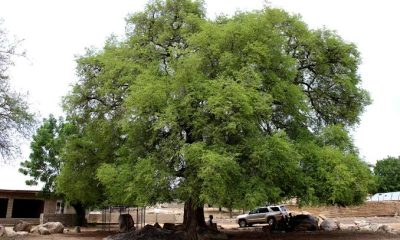News
Shifting Trends of Urban Mobility: Electric Scooter Ride is the New Normal

Shifting Trends of Urban Mobility: Electric Scooter Ride is the New Normal
By Faheem Daha
The recent decades have seen an outburst of technological advancements like never before. Modern devices and gadgets seep into our daily lives and replace outdated products effortlessly. Change is normal and a sign of liveliness. The bustling roads that were once a showplace for big cars are now witnessing a new scene. People today are more intrigued by restoring the environment to a healthy state. While it’s impossible to reset the environment in pristine condition. It will be still a success to conserve the environment at its present condition. It requires a lot of continuous effort, mindful practice choices and patience. Preferences of individuals are shaping the trends of urban mobility. One such hot-selling trending product is electric scooters. Each passing day a new e-scooter is joining the fleet. The proliferation of electric scooters in the urban transportation grid is compelling authorities to focus on the development of dedicated infrastructure for these single-occupancy vehicles.
Key triggers behind the surge of electric scooters
The post-pandemic world is facing the aftershocks of COVID-19. Global inflation is one such impact. Unstable fuel prices and unreasonably high car prices are a limiting factor in owning a personalized vehicle. Although the US economy is largely based on credit obtaining a car on lease is easier than the rest of the world. Yet every car leaves massive air pollution. Eco-friendly people are aggressively heading to electric stores to hit the best deal. What can be more exciting than enjoying an independent ride that is economical, convenient, and environment-friendly? You just need to have a few hundred bucks in your pocket to hit the right deal. No worries if you are out of budget, companies like LIME and Bird are offering electric scooters on rental service. Another good news is some states in the USA offer relaxed policies and GOvernment incentives for switching to this eco-friendly vehicle.
Impact of Electric scooters on the environment
Zero tailpipe emission
Conventional scooters draw power from combustion engines. On Average, a normal-sized motorcycle will add 0.18245kg of carbon dioxide to the atmosphere for every mile it covers. On the contrary electric scooters are surging in demand because of their zero to negligible tailpipe emissions. Thus conserving the air quality.
Bye Bye to frustration
Traffic congestion is one of the primary reasons for underperforming individuals. Juggling for way among different vehicles is an uphill task. Electric scooters can now navigate you easily through dedicated bike lanes in no time. Individuals can save a lot of time and conserve their productivity for onsite work. Similarly, returning home frustration-free can restore the domestic environment. It sounds cliche but fresh and healthy individuals are likely to make healthier choices. Just like frustrated peeps resort to cigarettes and alcohol, mindful buddies prefer activities that are safe for them and the environment too.
Critiquing the e-scooters from procurement to production
There has been an ongoing debate regarding the amount of carbon dioxide released into the atmosphere while extracting the raw materials, establishing production units to final delivery of e-scooters in the market. There is no denying in accepting that raw material extraction for e-scooters is undoubtedly an energy-intensive process. Yet, the initial environmental cost is offset by the far-reaching benefits it brings to the environment. Additionally, companies are looking for ways to reuse and recycle electrical components that can be retrieved from discarded products. Practices to make the extraction and production process efficient are underway.
Lesser emissions from idling vehicles
Idling vehicles despite being stationery still impart a carbon footprint to the environment since the engine is running and fuel is burning. The slim structure of electric scooters is a big plus. Navigation through populous terrains is swift and trouble-free. The e-scooter rider is a blessing for the rider himself and other road fellows. Why? Because the compactness of this scooter plays a big role in reducing congestion we can have fewer idling vehicles. Because of electric scooters riders’ fuel of other cars is conserved along with air quality. Isn’t that great? But it does not mean that car drivers keep on polluting the air. They also owe their fair share towards the betterment of the environment.
Electric scooters boast active commutation
E-scooters enable riders to engage in healthy lifestyles without compromising their physical limitation. Elderly people with back and leg pain discourage the idea of the outdoors as walking and bicycling appear tedious to them. Electric scooters besides conserving the environment conserve precious moments too. Like healthy individuals, weak people can enjoy cool breezes, friend reunions and nature walks equally on their much-loved e-scooters.
First and Last-mile commute
Using public transportation is always referred to as an environmentally friendly and cost-effective solution. However, a gap always exists between transit points and destinations. E-scooters fill this gap impeccably. No need to pay extra bucks now. As electric scooters have immense portability, they easily fill the gap from your place to the transit station. And then to the final destination.
No parking hassle
Escooter riders enjoy the liberty of hassle-free parking. Identifying a reasonable parking spot for cars is painstaking. Contrary to this you can effortlessly park the e-scooter at the specified area near the actual destination
Convenience on the go
Demand for escooters is surging in urban traffic dynamics. They are ideal, particularly for short trips. With the help of different smartphone applications, you can avail the convenience of riding on the go. Simply locate available e-scooters in your surroundings using the app, unlock and tada there you go! No more need to wait for transport to arrive. Electric scooter rides liberate you from the worries of fuel charges, waiting times, and traffic jams along with better air to breathe in.
There have been a lot of real-life stories advocating how electric scooters emerged as a real heroes. Be it a navigation through densely populated cities or becoming a travelling partner of environmental enthusiasts NANROBOT D6+2.0 never disappoints.
Electric scooters have challenges too
Like every product e-scooter industry has its challenges. Problems like vandalism. improper disposal and safety considerations have raised eyebrows. Public demand for a developed infrastructure is pressing the authorities whether to openly legalize vehicles or not. However, for every problem, there exists a solution. If e-scooter companies join hands with local stakeholders and municipal authorities, there exists a brighter chance that issues will be well taken care of.
Reference link: https://www.nature.org/en-us/get-involved/how-to-help/carbon-footprint-calculator/
https://www.escootersstores.com/pages/carbon-footprint-calculators
https://www.nationalgeographic.com/environment/article/what-is-a-carbon-footprint-how-to-measure-yours
https://earth.org/eco-friendly-travel-exploring-sustainable-tourism/
https://lifeloversmag.com/2024/01/18/how-to-stay-eco-whilst-on-the-road/
https://sustainabletravel.org/issues/carbon-footprint-tourism/
Faheem Daha, CEO of a pioneering electric scooter company in the USA, leads with a focus on sustainable urban mobility. His vision for eco-friendly commuting shapes the future of transportation
Shifting Trends of Urban Mobility: Electric Scooter Ride is the New Normal
News
U.S. president orders deadly strikes against ISIS militants in northwest Nigeria

U.S. president orders deadly strikes against ISIS militants in northwest Nigeria
By: Zagazola Makama
President Donald J. Trump announced that the United States had launched a powerful and deadly military strike against Islamic State (ISIS) terrorist targets in Nigeria, in response to what he described as ongoing attacks on primarily innocent Christians in the region.
In a post on his social media platform, Mr. Trump said the operation was conducted “at my direction as Commander in Chief” and targeted ISIS militants whom he accused of “viciously killing, primarily, innocent Christians, at levels not seen for many years, and even centuries.”
The president said he had previously warned the extremist group to halt attacks on Christians or face consequences, adding: “tonight, there was.”
Mr. Trump described the strikes as “numerous perfect strikes, as only the United States is capable of doing,” and reiterated that under his leadership the U.S. would not allow “Radical Islamic Terrorism to prosper.” He extended Christmas greetings to U.S. military forces and said there would be “many more” such strikes if the killing of Christians continued.
The announcement marks a significant escalation of U.S. military involvement in Nigeria’s complex security landscape. Western and Nigerian officials have long warned that militant groups such as ISIS’s West Africa Province (ISWAP) and Boko Haram pose a persistent threat in northern Nigeria, where attacks on civilians including Christians and Muslims alike have killed thousands over the past decade.
Reactions to the U.S. action are still emerging. The strikes come amid ongoing debates over Nigeria’s sovereignty and the best approach to combat extremist violence in West Africa. Previous statements by the Nigerian government welcomed U.S. assistance in fighting terrorism provided it respects the country’s territorial integrity.
The full military impact of the operation including casualties among militants or its implications for Nigeria’s internal security strategy has not yet been independently verified.
End
News
VP Shettima: Borno Attack Will Not Break Nigeria’s Resolve

VP Shettima: Borno Attack Will Not Break Nigeria’s Resolve
By: Our Reporter
Vice President Kashim Shettima has condemned in strong terms the bomb explosion that claimed about five lives and left several others injured at a Mosque in Gamboru Market, Maiduguri, Borno State, describing the attack as a despicable assault on innocent citizens and the peace of the nation.
The Vice President said President Bola Ahmed Tinubu has ordered an immediate intensification of security operations in Borno State following the incident.
In a statement on Thursday, the Vice President condemned the attack, assuring that the Federal Government is deploying additional tactical teams to the area to track down and apprehend those responsible for the terror attack.
“The Federal Government will not tolerate any attempt to undermine the peace and security of our nation. Our security agencies are working round the clock to ensure that the perpetrators of this heinous crime are brought to justice immediately,” he said.
Senator Shettima expressed confidence that the security architecture currently in place would not only apprehend the perpetrators but also unravel the full circumstances surrounding the incident.
“We sympathize with the Government of Borno State, residents, and families who have lost their loved ones in this attack. The Federal Government is confident that those responsible for this despicable act of terrorism will face the full weight of the law,” VP Shettima said.
He assured Nigerians that the Tinubu administration’s commitment to national security, anchored in constitutional duty, remains unwavering.
“Since President Bola Ahmed Tinubu assumed office in 2023, this administration has consistently reaffirmed its unyielding commitment to safeguarding the security, unity, and stability of our nation.
“This commitment remains steadfast under God and the Constitution of the Federal Republic of Nigeria. We will continue to provide our security agencies with all necessary resources and support to decisively defeat terrorism in all its forms,” he affirmed.
The Vice President added that the Federal Government is working closely with state authorities and local security agencies to ensure protection of vulnerable communities and critical infrastructure across the North East and other regions.
VP Shettima: Borno Attack Will Not Break Nigeria’s Resolve
News
Zulum-“Protect Our Sacred Bond,” Celebrates Peaceful Year in Christmas Message

Zulum-“Protect Our Sacred Bond,” Celebrates Peaceful Year in Christmas Message
By: Our Reporter
With profound gratitude to God for sparing our lives one full year to another Christmas celebration, Borno State Governor, Professor Babagana Umara Zulum felicitate with the Christian community across the state on the occasion of Christmas.
The Governor is currently engaged in a four-day security and resilience building tour across Northern Borno. The tour includes visits to military formations to boost their morale, and to communities affected by the insurgency, where he is working to build their confidence and provide tangible democratic benefits.
In a message by his Spokesperson Dauda Iliya, Governor Zulum expressed gratitude to God Almighty for the return of relative peace in the state.
“For us in Borno State, the period between the 2024 to the 2025 Christmas celebrations has been one full year of celebrating enviable all-encompassing reconstruction and recovery,” Zulum stated.
“The progress is not only in terms of physical infrastructure, but also in terms of the peace and forbearance, mutual goodwill and harmonious coexistence among the Muslim and Christian communities, which our beleaguered state very critically desires to launch itself back to prosperity and glorious past,” he added.
“I feel obliged to express my most heartfelt gratitude to God for enabling me to preside over the state one full year, witnessing a gladdening restoration and maintenance of these required peace, mutual goodwill and harmony between the the Muslim and Christian communities which bonded us tightly together as a solid people, but which the over a decade Boko Haram insurgency threatened to completely destroy.
“A noteworthy part of the Muslim-Christian harmonious coexistence and goodwill reconstruction and maintenance was my recent high-level consultation meeting with the leadership of Jama’atu Nasril Islam (JNI) and Christian Association of Nigeria (CAN), focused on strengthening collaborative efforts between the state government and religious bodies to combat the lingering threat of insecurity and foster lasting peace in Borno State.
“At that meeting, I underscored the critical role of religious leaders in promoting tolerance, unity and peace across the state because Borno, like many states, has unique and beautiful family composition dynamics.
“It is common to find under one roof, brothers and sisters, uncles and aunts, who profess different faiths. We share meals, we celebrate festivities and milestones, we grieve losses together, as one family, bound by blood and love that transcends religious labels. This is our reality.
“I stressed that our enviable strength emanates from this reality. I will still, therefore, stress that we must protect this sacred bond within our homes and allow it to define our individual, as well as intra- and cross-community engagements.
“In sustenance of my tradition of just, fair and equitable treatment of both communities in festive seasons, I have, also, this year, I announced support to the Christian community and non indigenes, which includes free transportation to non-indigenes to different parts of the country, humanitarian support to over 6,000 vulnerable Christians, cash gifts to widows and orphans, sponsorship of Christian pilgrimage and other interventions.
I am always disposed to rendering such support, and even more, whenever the need arises.
Governor Babagana Zulum urge every citizen of the state, irrespective of faith, to come together in the collective search for lasting security, peaceful and harmonious coexistence as the most-critical foundation for true reconstruction, recovery and prosperity.
Zulum-“Protect Our Sacred Bond,” Celebrates Peaceful Year in Christmas Message
-

 News2 years ago
News2 years agoRoger Federer’s Shock as DNA Results Reveal Myla and Charlene Are Not His Biological Children
-

 Opinions4 years ago
Opinions4 years agoTHE PLIGHT OF FARIDA
-

 News8 months ago
News8 months agoFAILED COUP IN BURKINA FASO: HOW TRAORÉ NARROWLY ESCAPED ASSASSINATION PLOT AMID FOREIGN INTERFERENCE CLAIMS
-

 Opinions4 years ago
Opinions4 years agoPOLICE CHARGE ROOMS, A MINTING PRESS
-

 News2 years ago
News2 years agoEYN: Rev. Billi, Distortion of History, and The Living Tamarind Tree
-

 ACADEMICS2 years ago
ACADEMICS2 years agoA History of Biu” (2015) and The Lingering Bura-Pabir Question (1)
-

 Columns2 years ago
Columns2 years agoArmy University Biu: There is certain interest, but certainly not from Borno.
-

 Opinions2 years ago
Opinions2 years agoTinubu,Shettima: The epidemic of economic, insecurity in Nigeria





